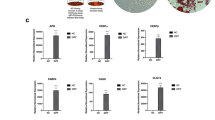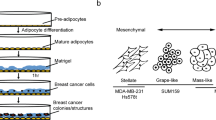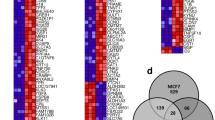Abstract
Adipocytes are known to be involved in epithelial-mesenchymal transition (EMT) in several cancers. However, the role of adipocytes in the EMT of breast cancer cells is poorly understood. The purpose of this study was to investigate the involvement of adipocytes in the EMT in breast cancer. Breast cancer cell lines MCF-7, MDA-MB-453, MDA-MB-435S, MDA-MB-231, and MDA-MB-468 were co-cultured with adipocytes and analyzed for morphological changes, proliferation activity, EMT markers, migration, and invasion. In addition, 296 human breast cancer specimens were classified according to the presence of the fibrous or adipose stroma and analyzed by immunohistochemistry for the expression of estrogen and progesterone receptors, human epidermal growth factor receptor 2, antigen Ki-67, N-cadherin, Twist-related protein 1 (TWIST1), high-mobility group AT-hook 2, TGFβ, and S100 calcium-binding protein A4 using tissue microarray. After co-culture with adipocytes, MCF-7, MDA-MB-435S, and MDA-MB-231 cells exhibited elongated spindle-like morphology and increased proliferation; MDA-MB-435S and MDA-MB-231 cells also showed increased dispersion. In all tested breast cancer cells, adipocytes induced migration and invasion. The EMT-like phenotypic changes and increased cell migration and invasion were accompanied by the upregulation of matrix metallopeptidase 9 and TWIST1. Consistently, breast cancer tumors with the adipose stroma showed higher TWIST1 expression than those with the adipose stroma; however, no difference was observed in the levels of other EMT-related proteins. Adipocytes stimulate breast cancer cells to acquire aggressive tumor phenotype by inducing EMT-associated traits, and breast cancer with the adipose stroma expresses EMT markers as breast cancer with the fibrous stroma.





Similar content being viewed by others
References
Duband JL, Monier F, Delannet M et al (1995) Epithelium-mesenchyme transition during neural crest development. Acta Anat (Basel) 154(1):63–78
Kalluri R, Neilson EG (2003) Epithelial-mesenchymal transition and its implications for fibrosis. J Clin Investig 112(12):1776–1784. doi:10.1172/jci20530
Thiery JP (2002) Epithelial-mesenchymal transitions in tumour progression. Nat Rev Cancer 2(6):442–454. doi:10.1038/nrc822
Hay ED (1995) An overview of epithelio-mesenchymal transformation. Acta Anat (Basel) 154(1):8–20
Lee JM, Dedhar S, Kalluri R et al (2006) The epithelial-mesenchymal transition: new insights in signaling, development, and disease. J Cell Biol 172(7):973–981. doi:10.1083/jcb.200601018
Thiery JP, Sleeman JP (2006) Complex networks orchestrate epithelial-mesenchymal transitions. Nat Rev Mol Cell Biol 7(2):131–142. doi:10.1038/nrm1835
Blick T, Widodo E, Hugo H et al (2008) Epithelial mesenchymal transition traits in human breast cancer cell lines. Clin Exp Metastasis 25(6):629–642. doi:10.1007/s10585-008-9170-6
Sarrio D, Rodriguez-Pinilla SM, Hardisson D et al (2008) Epithelial-mesenchymal transition in breast cancer relates to the basal-like phenotype. Cancer Res 68(4):989–997. doi:10.1158/0008-5472.can-07-2017
Mani SA, Guo W, Liao MJ et al (2008) The epithelial-mesenchymal transition generates cells with properties of stem cells. Cell 133(4):704–715. doi:10.1016/j.cell.2008.03.027
Morel AP, Lievre M, Thomas C et al (2008) Generation of breast cancer stem cells through epithelial-mesenchymal transition. PLoS ONE 3(8):e2888. doi:10.1371/journal.pone.0002888
Debies MT, Gestl SA, Mathers JL et al (2008) Tumor escape in a Wnt1-dependent mouse breast cancer model is enabled by p19Arf/p53 pathway lesions but not p16 Ink4a loss. J Clin Investig 118(1):51–63. doi:10.1172/jci33320
Moody SE, Perez D, Pan TC et al (2005) The transcriptional repressor snail promotes mammary tumor recurrence. Cancer Cell 8(3):197–209. doi:10.1016/j.ccr.2005.07.009
Yu Y, Xiao CH, Tan LD et al (2014) Cancer-associated fibroblasts induce epithelial-mesenchymal transition of breast cancer cells through paracrine TGF-beta signalling. Br J Cancer 110(3):724–732. doi:10.1038/bjc.2013.768
Kushiro K, Chu RA, Verma A et al (2012) Adipocytes promote B16BL6 melanoma cell invasion and the epithelial-to-mesenchymal transition. Cancer Microenviron 5(1):73–82. doi:10.1007/s12307-011-0087-2
Sadowski HB, Wheeler TT, Young DA (1992) Gene expression during 3T3-L1 adipocyte differentiation. Characterization of initial responses to the inducing agents and changes during commitment to differentiation. J Biol Chem 267(7):4722–4731
Kim S, Lee Y, Koo JS (2015) Differential expression of lipid metabolism-related proteins in different breast cancer subtypes. PLoS ONE 10(3):e0119473. doi:10.1371/journal.pone.0119473
Hammond ME, Hayes DF, Dowsett M et al (2010) American Society of Clinical Oncology/College of American Pathologists guideline recommendations for immunohistochemical testing of estrogen and progesterone receptors in breast cancer (unabridged version). Arch Pathol Lab Med 134(7):e48–e72. doi:10.1043/1543-2165-134.7.e48
Wolff AC, Hammond ME, Hicks DG et al (2013) Recommendations for human epidermal growth factor receptor 2 testing in breast cancer: American Society of Clinical Oncology/College of American Pathologists clinical practice guideline update. J Clin Oncol 31(31):3997–4013. doi:10.1200/jco.2013.50.9984
Henry LR, Lee HO, Lee JS et al (2007) Clinical implications of fibroblast activation protein in patients with colon cancer. Clin Cancer Res 13(6):1736–1741. doi:10.1158/1078-0432.ccr-06-1746
Luo Y, Lan L, Jiang YG et al (2013) Epithelial-mesenchymal transition and migration of prostate cancer stem cells is driven by cancer-associated fibroblasts in an HIF-1alpha/beta-catenin-dependent pathway. Mol Cells 36(2):138–144. doi:10.1007/s10059-013-0096-8
Taki M, Higashikawa K, Yoneda S et al (2008) Up-regulation of stromal cell-derived factor-1alpha and its receptor CXCR4 expression accompanied with epithelial-mesenchymal transition in human oral squamous cell carcinoma. Oncol Rep 19(4):993–998
Zhou B, Chen WL, Wang YY et al (2014) A role for cancer-associated fibroblasts in inducing the epithelial-to-mesenchymal transition in human tongue squamous cell carcinoma. J Oral Pathol Med 43(8):585–592. doi:10.1111/jop.12172
Dirat B, Bochet L, Dabek M et al (2011) Cancer-associated adipocytes exhibit an activated phenotype and contribute to breast cancer invasion. Cancer Res 71(7):2455–2465. doi:10.1158/0008-5472.can-10-3323
Bochet L, Lehuede C, Dauvillier S et al (2013) Adipocyte-derived fibroblasts promote tumor progression and contribute to the desmoplastic reaction in breast cancer. Cancer Res 73(18):5657–5668. doi:10.1158/0008-5472.can-13-0530
Ogunwobi OO, Liu C (2012) Therapeutic and prognostic importance of epithelial-mesenchymal transition in liver cancers: insights from experimental models. Crit Rev Oncol Hematol 83(3):319–328. doi:10.1016/j.critrevonc.2011.11.007
Sawyer EJ, Hanby AM, Ellis P et al (2000) Molecular analysis of phyllodes tumors reveals distinct changes in the epithelial and stromal components. Am J Pathol 156(3):1093–1098. doi:10.1016/s0002-9440(10)64977-2
Wallerand H, Robert G, Pasticier G et al (2010) The epithelial-mesenchymal transition-inducing factor TWIST is an attractive target in advanced and/or metastatic bladder and prostate cancers. Urol Oncol 28(5):473–479. doi:10.1016/j.urolonc.2008.12.018
Acknowledgments
This study was supported by a grant from the National R&D Program for Cancer Control, Ministry of Health & Welfare, Republic of Korea (1420080). This research was supported by Basic Science Research Program through the National Research Foundation of Korea (NRF) funded by the Ministry of Science, ICT and Future Planning (2015R1A1A1A05001209).
Author information
Authors and Affiliations
Corresponding author
Ethics declarations
Conflict of interest
The authors declare that they have no conflict of interest.
Electronic supplementary material
Below is the link to the electronic supplementary material.
Rights and permissions
About this article
Cite this article
Lee, Y., Jung, W.H. & Koo, J.S. Adipocytes can induce epithelial-mesenchymal transition in breast cancer cells. Breast Cancer Res Treat 153, 323–335 (2015). https://doi.org/10.1007/s10549-015-3550-9
Received:
Accepted:
Published:
Issue Date:
DOI: https://doi.org/10.1007/s10549-015-3550-9




